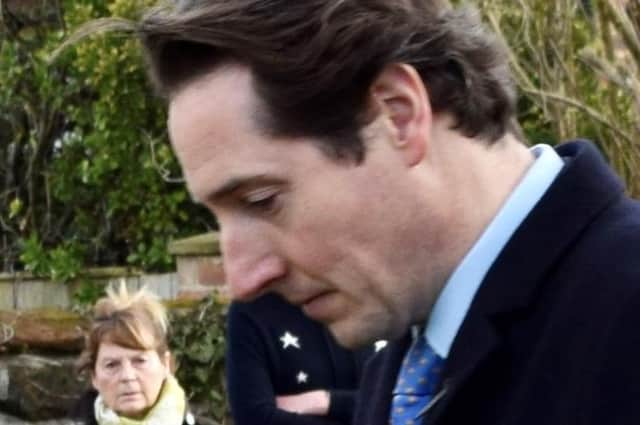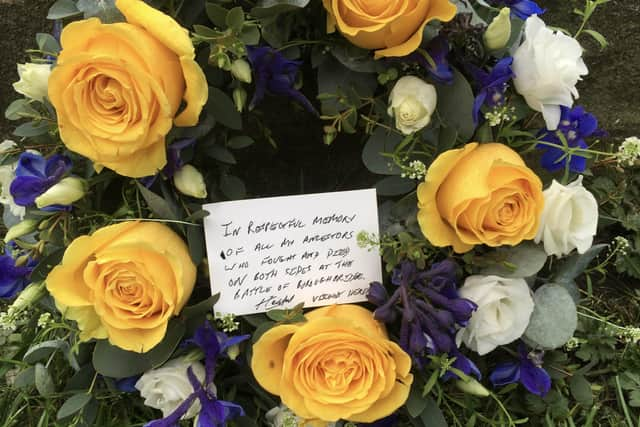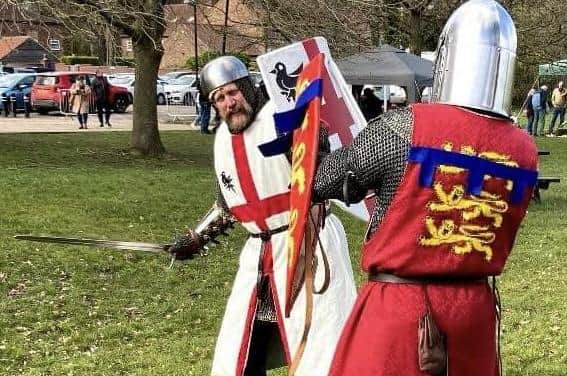Battle of Boroughbridge marked


Viscount Hereford, Robin de Bohun Devereux, a director of Bonhams Auctioneers, joined the Deputy Lieutenant of North Yorkshire, Richard Compton, of Newby Hall, who was present representing Her Majesty the Queen.
They, together with Boroughbridge’s Mayor, Coun Mrs Pat Taylor, and triplets from the Primary School – Daisy, Ben and Jake Godley – laid wreaths at the Battle Cross in Aldborough during a service led by John Francis Moss, of Aldborough and Boroughbridge Churches.
Advertisement
Hide AdAdvertisement
Hide AdThe event was organised by Boroughbridge and District Historical Society and the Battlefields Trust to mark the anniversary of a battle between the armies of King Edward II and Thomas, Earl of Lancaster, which was fought across the River Ure on March 16th, 1322.


Society secretary, Linda Dooks said: “We hope the people of Boroughbridge and surrounding villages, particularly children, now know more about the 1322 battle and that the Battlefield Trail and information boards will attract visitors and continue to inform for many years to come.
“The 700th anniversary involved a broad cross section of the community and provided an opportunity for people to meet old friends after the long lockdown. We are grateful to everybody involved.”
She said that, contrary to popular belief, the battle had nothing to do with the Scottish Wars pursued by Edward II and his father, Edward I.
Advertisement
Hide AdAdvertisement
Hide AdIt resulted from a decade of bitter antagonism between the king and his cousin, Lancaster, who regarded him as incompetent and corrupt.


Mrs Dooks added: “Events of 1322 will be permanently commemorated by a Battle Trail with five information boards researched, written and designed by two members of the Yorkshire Region of the Battlefields Trust, Louise Whitaker and Chris Rock.
“It is hoped the boards will be erected later this year after Harrogate Borough Council grants planning permission.
“They have been paid for with £15,000 provided by Miller Homes, which gave the Battlefields Trust a grant after being allowed to build houses adjoining part of the battle site at Milby.”
The wreath laying at Aldborough was watched by 75 people.
Advertisement
Hide AdAdvertisement
Hide AdAbout 500 attended the skill at arms display by the 3 Swords group, who perform at Leeds Royal Armouries Museum, and more than 150 people joined the two Battlefield Tour Walks led by Louise Whittaker.
Mrs Dooks set the record straight on the events leading up to the battle and afterwards:
Lancaster despised the king’s favourite, Piers Gaveston, who was appointed Regent while Edward was away in France. After growing conflict, Gaveston was captured at Scarborough Castle and executed on Lancaster’s orders - deepening the feud.
Lancaster and his followers were being pursued north after a defeat by Edward’s army at the Battle of Burton Bridge, near Burton-upon-Trent, on March 10th, 1322. They arrived at Boroughbridge on Tuesday, March 16th, intending to cross the River Ure.
Advertisement
Hide AdAdvertisement
Hide AdLancaster was aided by Sir Roger de Clifford and northern Barons and noblemen from the Welsh Marches, led by the Earl of Hereford, Sir Humphrey de Bohun. Their destination was Dunstanburgh Castle in Northumberland, where Lancaster hoped to secure support from the Scottish King, Robert the Bruce.
King Edward had enlisted Sir Andrew Harclay, Warden of Carlisle, to cut Lancaster off. Sir Andrew reached Ripon to discover Lancaster was approaching Boroughbridge. He marched overnight with 4,000 men from Cumberland and Westmorland, to secure the north bank of the Ure, the timber bridge and the ford
Lancaster, who was heavily outnumbered, had no alternative than to fight across the river. The Earl of Hereford attempted to take the bridge, assisted by Clifford, while the cavalry, commanded by Lancaster, tried to cross the ford, which is believed to have been downstream of the town.
At the bridge, Hereford was faced with a schiltron – a compact body of pikemen in a defensive shield. One historic source claims Hereford was killed by a pikeman, who pierced his armour by thrusting a spear upwards from beneath the bridge, disembowelling him.
Advertisement
Hide AdAdvertisement
Hide AdThe attack at the ford fared little better. Lancaster and his cavalry were charging from open meadows and came under an arrow storm from archers armed with powerful and accurate longbows. The cavalry was forced to retreat before even reaching the water’s edge.
It was a short and one-sided battle. Sir Roger de Clifford, who had been seriously injured by pike and arrow at the bridge, withdrew. Lancaster sought sanctuary in the original Boroughbridge Church, which stood on St James’s Square.
An overnight truce was negotiated. But the High Sheriff of Yorkshire, Sir Simon de Ward, from Givendale, near Ripon, arrived to reinforce Harclay’s army. Early in the morning, they took prisoner those of Lancaster’s army who had not deserted.
The defeated rebels were escorted to York for trial. Lancaster was taken to his castle in Pontefract. He was sentenced to be hung, drawn and quartered, but suffered a merciful beheading on March 22nd. Sir Roger de Clifford was hung from the tower beside the River Ouse in York, which still bears his name.
Advertisement
Hide AdAdvertisement
Hide AdA total of 214 knights and nobles are listed as having fought in the battle with only 76 on the Royal side. The death toll is unknown. Thirty of Lancaster’s followers were executed at sites across the country as the king’s warning to other rebels.
Sir Andrew Harclay was created Earl of Carlisle for loyalty to King Edward but was later executed for making a pact with the Scots. In 1327, Edward’s wife, Isabella of France, was part of a coup and her 14-year-old son, Edward III, became king. Her husband, 43, abdicated, was imprisoned and died – probably murdered – later that year.